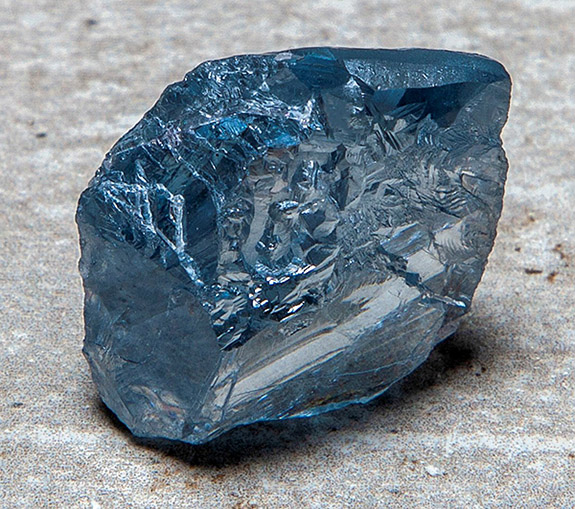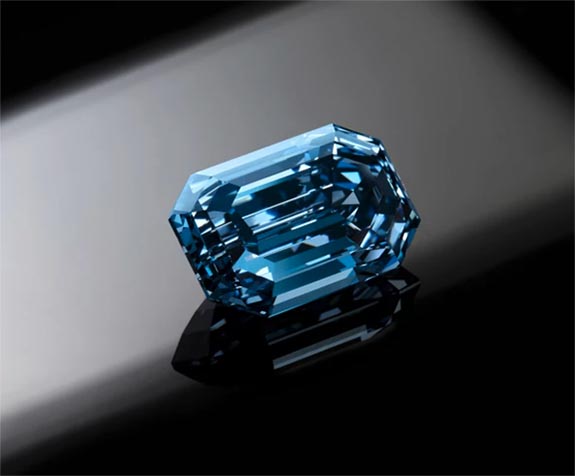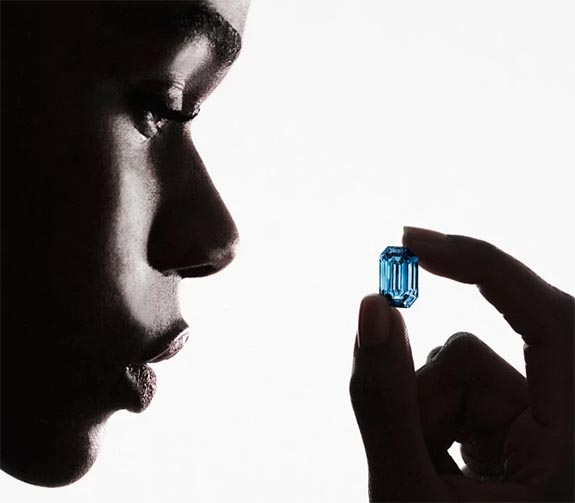Sotheby's Unveils 15.10-Carat Flawless, Step-Cut, Fancy Vivid Blue Diamond

That 29.6-carat rough stone was subsequently transformed into a 12.03-carat, internally flawless, cushion-cut, fancy vivid blue headliner that would be named The Blue Moon of Josephine. In 2015, the polished gem was sold at a Sotheby’s auction for $48.5 million, or more than $4 million per carat. It was the highest price per carat ever paid for a diamond.
The Blue Moon of Josephine maintained nearly 41% of its total weight during the cutting process. We mused that if the same percentage held true for the 39.34-carat blue diamond unearthed in 2021, the result would be a 16-carat finished gem. At $4 million per carat, the gem might be worth $64 million.

Well, last week Sotheby's revealed the progeny of the 39.34-carat blue rough. Named "The De Beers Cullinan Blue," the 15.10-carat, step-cut, fancy vivid blue diamond retained 38.4% of its weight during the arduous cutting process and earned the rating of internally flawless from the Gemological Institute of America (GIA). The gem was fashioned into its step-cut shape by Diacore’s master diamond cutters working in concert with De Beers.
Billed as the largest vivid blue diamond ever to appear at auction and the largest internally flawless step-cut vivid blue diamond that the GIA has ever graded, The De Beers Cullinan Blue could prove to be a record holder when it hits the auction block at Sotheby's Hong Kong on April 27.
As the star of a single-lot auction, the rare gem is expected to fetch at least $45 million ($2.98 million per carat), but could sell for much more.
In May 2016, the slightly smaller, 14.62-carat fancy vivid blue diamond dubbed the Oppenheimer Blue fetched an astounding $57.5 million ($3.93 million per carat) at Christie’s Geneva. While The De Beers Cullinan Blue is rated internally flawless, the Oppenheimer Blue is one grade below at VVS1 clarity.
Sotheby's noted that blue diamonds of this importance are exceptionally rare, with only five examples over 10 carats ever having come to auction. Until now, none had exceeded 15 carats.
“[The De Beers Cullinan Blue] ranks as one of the best De Beers has ever seen," noted Bruce Cleaver, CEO of De Beers Group. "It is extremely rare and unique, and as the Home of Diamonds, De Beers is pleased to join together with Sotheby’s to bring this diamond to the world.”
According to the GIA Monograph, achieving the fancy vivid color grade in a step-cut gem is a remarkable achievement.
The GIA wrote, "To achieve a Fancy Vivid grade with a step cut or emerald cut, the inherent body-color has to be stronger than virtually every other fancy shape.”
The auction house added that while other colored diamonds can be found in mines around the world, there are very few sources for blue diamonds, most of which are recovered from the Cullinan mine in South Africa.
Trace amounts of the chemical element boron are responsible for causing the coloration of natural blue diamonds. According to the Museum of Natural History, “less than one boron atom per million carbon atoms is sufficient to produce the blue coloration.”
The De Beers Cullinan Blue is currently on a promotional tour that will make stops in New York, London, Dubai, Singapore, Taipei, Shanghai, Beijing and Shenzhen.
Credits: De Beers Cullinan Blue images courtesy of Sotheby's. Rough diamond image courtesy of Diacore.

